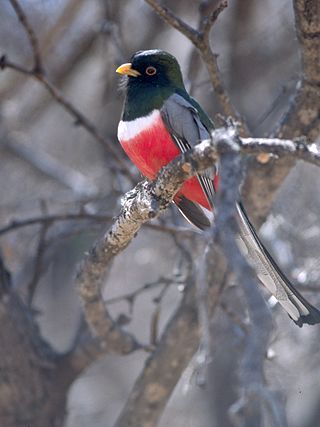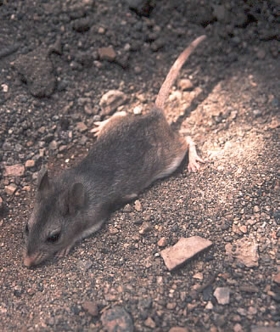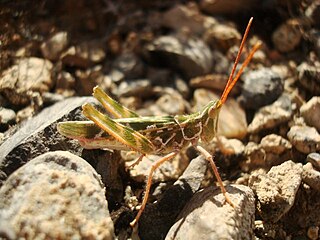
Mount Graham is a mountain in Graham County, Arizona, United States, approximately 70 miles (110 km) northeast of Tucson. The mountain reaches 10,724 feet (3,269 m) in height. It is the highest elevation in Graham County, Coronado National Forest and the Pinaleño Mountains. It is also the southernmost peak and land area in the continental United States above 10,000 feet (3,048 m). As the name "Mount Graham" is often used by locals to refer to the entire mountain range, the peak itself is frequently referred to as "High Peak". It is twentieth of the 57 ultra-prominent peaks of the lower 48 states, and the first of the five in Arizona.

The Apache trout or Arizona trout, Oncorhynchus apache, is a species of freshwater fish in the salmon family of order Salmoniformes. It is one of the Pacific trouts.

The spotted bat is a species of vesper bat and the only species of the genus Euderma.

The elegant trogon, previously known as the coppery-tailed trogon, is a near passerine bird in the trogon family native to Central America. The etymology of the word trogon comes from the Greek word trōgein, meaning "to gnaw", which describes how this species prepares its nests in trees.

The Pinaleño Mountains, are a remote mountain range in southeastern Arizona, near Safford, Arizona. The mountains have over 7,000 feet (2,100 m) of vertical relief, more than any other range in the state. The mountains are surrounded by the Sonoran-Chihuahuan Desert. Subalpine forests cover the higher elevations. According to The Nature Conservancy, they traverse five ecological communities and contain "the highest diversity of habitats of any mountain range in North America." The highest point is Mount Graham at 10,720 feet (3,267 m). Locals often refer to the whole mountain range as "Mount Graham", in which case the peak is referred to as "High Peak". The mountains cover 300 square miles (780 km2) and are part of the Coronado National Forest, Safford ranger district.

The western mastiff bat, also known as the western bonneted bat, the greater mastiff bat, or the greater bonneted bat, is a member of the free-tailed bat family, Molossidae. It is found in the Western United States, Mexico and South America. This species is the largest bat native to North America, and some of its distinguishing characteristics are its large ears, wings, and forearms. The subspecies Eumops perotis californicus is a species of concern as identified by the U.S. Fish and Wildlife Service. The range of this subspecies is principally southwest desert regions of the United States, along the border with Mexico; however, the range extends as far north on the Pacific coast as Alameda County, California.

The southern grasshopper mouse or scorpion mouse is a species of predatory rodent in the family Cricetidae, native to Mexico and the states of Arizona, California, Nevada, New Mexico, and Utah in the United States. Notable for its resistance to venom, it routinely preys on the highly venomous Arizona bark scorpion.

Acrolophitus pulchellus is a species of grasshopper in the family Acrididae. It is endemic to Idaho in the United States. Its common name is Idaho point-headed grasshopper.
Appalachia arcana is a species of grasshopper in the family Acrididae. It is known by the common names Michigan bog grasshopper and secretive locust. It is the only grasshopper that is endemic to Michigan in the United States.
Eumorsea is a genus of grasshoppers in the family Eumastacidae, the monkey grasshoppers.
Schayera baiulus is a species of grasshopper in the family of the Acrididae. The species is endemic to the Northern Region of Tasmania in Australia. The species is extremely rare and critically endangered, with only five confirmed specimens ever found.
Spaniacris deserticola is a species of grasshopper in the family Romaleidae known as the Coachella Valley grasshopper and spanistic desert grasshopper. It is known from a few locations in the deserts of southern California and just across the border in Sonora, Mexico.
The Zayante band-winged grasshopper is a species of insect in the family Acrididae. It is endemic to a small portion of the Santa Cruz Mountains in California.

The northern grasshopper mouse is a North American carnivorous rodent of the family Cricetidae. It ranges over much of the western part of the continent, from southern Saskatchewan and central Washington to Tamaulipas in northeast Mexico.
Erigeron heliographis is a rare species of flowering plant in the family Asteraceae known by the common name Heliograph Peak fleabane. It is endemic to Arizona, where it occurs only in the Pinaleno Mountains in Graham County.
Hymenoxys ambigens is a species of flowering plant in the daisy family known by the common name Pinaleño Mountains rubberweed. It is native to the states of Arizona and New Mexico in the southwestern United States.
Melanoplus pinaleno, the pinaleno short-wing grasshopper, is a species of spur-throated grasshopper in the family Acrididae. It is found in North America.
Eumorsea balli, known generally as the huachuca monkey grasshopper or Ball's monkey grasshopper, is a species of monkey grasshopper in the family Eumastacidae. It is found in North America.









